
One Year of AVAwire!
AVAproject Fusion Series: No. 6, Columnar Reports – “A Fresh Approach to a Traditional Task”
AVAware Article Featured in August 2011 DHI Magazine
Raising the “Profile” of your Submittals
Raise Your “Profile” Even More... with Manufacturers’ Catalogs
AVAproject Tip: Coordinating Frame Profiles with Their Openings and Components

 U.S. Price Books: U.S. Price Books:
 Canadian Price Books: Canadian Price Books:
|

|

|
|

|
One Year of AVAwire!
It was one year ago that the AVAware team decided to launch our first company newsletter. One year and twelve issues later we’re still going strong!
|
|
For many years, the team at AVAware has eagerly discussed the possibility of publishing a monthly company newsletter. Until recently, we’ve never felt we were in a position to take on that responsibility and do it justice. Though one may not immediately realize it, it is a tremendous commitment and a very daunting prospect for a group of people that do not have a single professional writer amongst them. Once the ball starts rolling, there is no turning back. We are committed to publishing a quality product month after month.
We’ve all seen companies take it upon themselves to begin writing monthly features only to see the enthusiasm and ultimately the commitment dwindle over time. What begins as a monthly publication eventually becomes a quarterly publication. At some point they de-evolve into occasional “special editions” or semi-annual “announcements”, until the effort is finally abandoned. In all fairness, trying to motivate non-writers into contributing material every month is a difficult task at best. It takes an abundant supply of discipline
|
and creativity to keep a company publication alive and vibrant, month after month. Fortunately, there is no shortage of highly disciplined, creative people at AVAware.
Without a doubt, the most challenging aspect of creating a monthly newsletter is coming up with fresh content on an ongoing basis. For a large company such as Microsoft or Oracle, this task is made easier by the fact that they have so many departments and so many ongoing projects to report on. For the longest time we didn’t feel AVAware had enough projects on at any given time to even allow for, never mind necessitate a newsletter. We are very proud to be able to say that our outstanding development team have given us a great deal to talk about.
The final and perhaps greatest concern we had for our fledgling newsletter was how well it would be received. We had no idea whether anyone would take the time to read it or whether it would become fodder for spam filters around the world. Fortunately, the responses we’ve received from both clients and non-clients alike
|
have been overwhelmingly positive. Hardly a month has gone by where we haven’t received subscription requests from people who have had colleague’s forward copies of AVAwire to them.
Many of us put a great deal of work into the publication every month, trying to ensure that the content is not only informative but relevant to as many of our readers as possible. It’s incredibly gratifying to receive the enthusiastic feedback and support that they’ve given us. To all of you we offer our sincerest thanks!
As we move into our second year of publication, we are even more committed to providing a valuable (and perhaps entertaining) resource to all our subscribers. To that end, we would very much appreciate any feedback you feel inclined to offer. If you have any questions of a technical nature or ideas for articles that you feel others would be interested in, please pass them along to us. Above all else, this publication is for you, and we want to hear your comments - kind or otherwise. ☺
|
AVAproject Fusion Series:
No. 6, Columnar Reports – “A Fresh Approach to a Traditional Task”
|

|
This is the sixth in our special series of articles profiling our newest product offering: AVAproject Fusion. Fusion is about mastering your data. Information from AVAproject or virtually any other Windows-compatible data source can be brought together, manipulated, reported on and reformatted for use in other applications. See your data any way you can imagine it.
|
|
A previous article in this series focused on the powerful pivot table style reporting features of AVAproject Fusion. The most common type of report, however, is of the traditional columnar variety. As its name implies, data fields are arranged in columns within a report format. At the user’s option, data within these
|
columns can be sorted and/or grouped based upon the data in any or all of fields.
The user interface is similar to that of the pivot table builder. The field chooser provides access to any and all fields in the Combined Information Pool. Based upon the AVAproject Material List, this
|
enhanced version is linked to all the source tables (openings schedules, hardware groups, etc.) from which the material list is generated.
The report is built by simply dragging fields into the “Columns” box. For each field selected, additional options pertaining to column widths and alignments are available.
|
|

The AVAproject Fusion Report Builder Interface
|
|
Sorting can be performed based on any or all of the fields chosen. To activate a sort field, one must only select the appropriate check box. Sort fields are also listed in a secondary list below the “Columns” box. The sort order can be specified notwithstanding the order in which the columns appear on the report.
Finally, the report items can be broken into groups based upon the data in any or all of the columns. Once again, one must simply select the columns for which data should be grouped and optionally sub-totaled.
|

The AVAproject Fusion Report Builder Column Properties
|
|
Like the pivot tables, numerous options are given in terms of how data is to be aggregated at the bottom of the each group and the
|
entire report. Once a report has been configured to the user’s satisfaction, it can be saved to either the current file or to a
|
library. Libraries can be applied to any other project files in the future and distributed to other users.
|
|

|
What's Next for Fusion?
|
|
AVAproject Fusion allows the most sophisticated of reports to be designed in mere seconds. Once again, tasks that are normally relegated to the IT department and / or IT professionals can be performed by users with little or no technical knowledge. Herein lies the greatest feature Fusion has to offer.
Throughout this series of articles, we have discussed numerous powerful data basing and reporting features built directly into the product. Although none is
|
entirely unique in and of itself, their implementation absolutely is. Fusion’s revolutionary user interface and intelligent data access engine provide a powerful set of tools that will become the basis for countless future companion products.
The first such series of companion products will involve accounting interfaces to a variety of popular accounting applications and platforms.
Over the next few months, AVAware will be prototyping
|
interfaces for the following applications: - Intuit QuickBooks
- Sage PeachTree
- Microsoft Dynamics GP (Great Plains)
- Microsoft Dynamics NAV (Navision)
Support for additional accounting applications will be added based upon users’ requests and popularity. Please consult future editions of AVAwire or visit the AVAware website for updated product release information.
|
|
Many of the concepts discussed in this article are expanded upon in the AVAware publication: "AVAproject Fusion: Theory of Operation". In it, data structures and the interaction between project components are illustrated in much greater detail. This comprehensive document is available in the Downloads section of the AVAware website.
|
|
|

|
AVAware Article Featured in
August 2011 DHI Magazine
The architectural openings industry's premier publication, Doors & Hardware Magazine, featured yet another article from AVAware in its August 2011 issue.
"What Makes a Network Application", authored by AVAware President & CEO Paul Kirsch, describes common computer network configurations, the strengths and weaknesses of these configurations, and finally the relationship of software and data when used in a network environment.
Stay tuned for upcoming AVAware features in the DHI Magazine.
|
|
|
Raising the “Profile” of your Submittals
|

|
If it’s true that you “only get one chance to make a first impression”, then for an architectural openings distributor nothing is more important that their Submittal documents. They are the first opportunity that clients and architects have to form an impression of the firm, their professionalism and their capabilities. The unrivaled graphics capabilities of AVAproject and AVAcad will help ensure that stunning first impression.
|
|
There are several key components that make up a standard submittal package. One of the most important and time-consuming of them is the frame cross-sections or “profiles”. To begin with, frame geometry can vary dramatically from project to project. Beyond that, architects and designers will often do their very best to create unique frame profiles just to give interior openings a unique “look” or signature. Add to all of that the variations that exist between manufacturers, not to mention the architects’ insistence on accuracy and you have an arduous task that is second to none.
Traditionally, many distributors have settled for pre-drawn libraries of cross-sections that generally represent standard scales and ratios between dimensions. In fact, most detailing software packages use an identical technique of simply drawing “typicals” from a pre-drawn library of bitmap images. Needless to say, this is far from accurate. Although one can certainly “write-in” the correct dimensions, the drawings are not to real scale and the various line lengths are never in the correct proportion to each other. Beyond that, no one can obviously anticipate every possible configuration of frame geometry. Any given profile can exist with a variety of back-bends, rabbet and
|
returns just to name a few of the variables that are constantly changing. Placement of doors and glass in context of the profile, based on glazing options and swing direction, only multiplies the possibilities.
It’s for these reasons that AVAproject and AVAcad were created with a sophisticated profile generation facility that is absolutely unmatched. The software comes pre-loaded with the equations behind a number of standard frame profiles – NOT simply bitmapped images of them. As such, the system can literally “draw” any profile to actual scale and proportion based on the parametric values provided. In this way, AVAproject mimics that same functionality found in engineering packages such as Autodesk’s “Mechanical Desktop”. Using parametric values supplied on either a project-wide or per-opening basis (examples depicted below) the software is able to generate the appropriate cross-section detail.
Based upon the placement of any doors, panels or windows in the elevation, those components’ positions are properly represented and any related parameters (i.e. rabbet width or stop height) are automatically adjusted to accommodate them. Obviously, components are positioned on
|
either rabbet based upon the either the swing direction or the inside/outside placement. Beyond that, AVAproject will accurately depict glazing bead based upon the specified width and height, and special applications such as flush and double glazing have their custom parameters automatically calculated and rendered.
Pictured below are just a small sampling of the virtually limitless numbers of different profiles that can be generated though the standard “Generic Hollow Metal” catalog that ships with AVAproject. These show standard profiles (single, double, equal and unequal rabbet) along with simple cased-open frames. They can all be paired with any of a number of backing options, including single and double bend, drywall, shadow line, double egress (2 types) and cased-open to name a few. In addition, mullions can be formed by any combination of profiles.
All profiles can be printed with or without dimensions shown. It’s also important to mention that since these profiles are being drawn to specification, they can also be scaled to any virtually size your printing device can support with absolutely no degradation, loss of quality or ‘jagged lines’ that are typical of bitmap libraries.
|
|
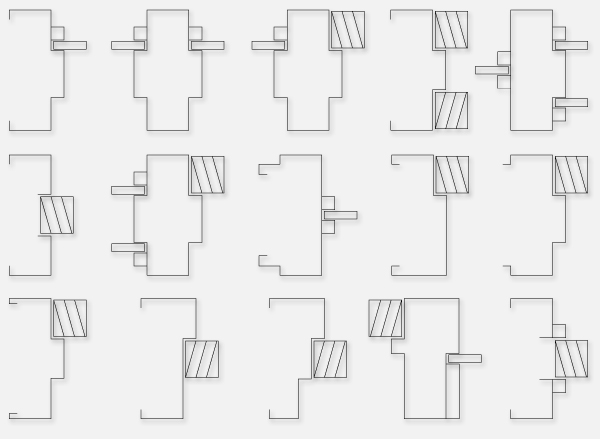
Samples of Hollow Metal Frame Profiles drawn by AVAproject based on parametric values
|
|
Don’t Forget the Wood Frames...
In addition to the “Generic Hollow Metal” catalog, AVAproject also ships with a “Generic Wood” catalog. Along with numerous standard wood-related options and nomenclature, a supplementary profile library or wood frame details in also included.
The following are a selection of samples produced by AVAproject for wooden frames. They represent products such as applied stop, ‘T’ stop, and rabbeted stop profiles to name a few.
|
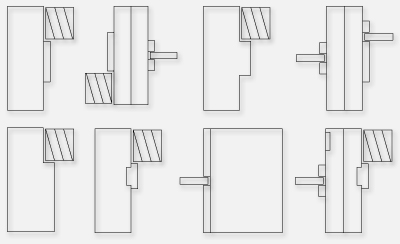
Samples of Wood Frame Profiles drawn by AVAproject based on parametric values
|
|
Just like their hollow metal counterparts, these profiles can also depict the placement of doors, panels and windows. In addition, they are also drawn based upon user-supplied parametric values. As such the possible combinations are limited only to anything one can describe with numbers. In other words, the possibilities are limitless!
Even More Options...
The features and possibilities offered by AVAproject and AVAcad profile rendering engine don’t stop with the examples given here. There a great number of additional “intelligence” options contained within the software that govern how the individual profiles are constructed in the project context.
|
For example, rabbets can be made to automatically resize to accommodate doors of varying thickness. This “automatic resizing” can be selectively overridden for specific openings to facilitate unique or ‘unusual’ applications. The system can be given specific parameters with respect to every miniscule aspect of the frame’s geometry. Rabbet oversizing, glass and panel stand-offs and door gaps are only a few of the values that can be set by the user as required. The multitude of automation components that drive this feature could fill an article on their own. (And they probably will very soon.)
Suffice it to say that AVAproject can satisfy the needs of the most demanding architects and engineers. Unlike distributors that still rely on traditional CAD/drawing systems or (gasp!) hand-drawn
|
submittals, AVAproject users can respond to changes and change orders in record-breaking time. As quickly as one can change a given parametric value, the entire project’s frame profiles can be re-drawn instantly. Remember that all-important “first impression”? Why not make the “second impression” even more impressive? Nothing demonstrates responsiveness like being able to process a change and regenerate a submittal document in mere minutes. We’re very proud to say that in many areas AVAproject users have already raised the bar in terms of supporting their clients. Several have reported that their new-found “responsiveness” and the documents they can produce with AVAproject have become a standard that is almost “expected” by regional architects.
|
Raise Your “Profile” Even More... with Manufacturers’ Catalogs
|
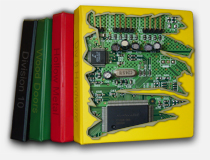
|
Despite the unmatched depth and flexibility offered by the standard AVAproject and AVAcad profile library, there are always more frame types to consider. Manufacturers often have their own individual and proprietary frame profiles that are offered in their product lines.
|
|
AVAware has published approximately 28 hollow metal, aluminum and wood product catalogs, making this library the largest offered by any software company servicing architectural openings industry today. In last month’s edition of AVAwire, we explored some of the unique capabilities of these catalogs from a product pricing point of view.
|
Another aspect that makes them so powerful is that they are capable of carrying supplemental libraries of frame profiles to further enhance the profile rendering engine in AVAproject and AVAcad.
In addition to their standard offerings, several manufacturer catalogs contain unique and exceptional profile templates that
|
can be included in documents such as submittals and shop drawings. Obviously, covering the features and contents of every catalog in the AVAware library is beyond the scope of a single article. However, the following is a representative sampling of some of our favorites...
|
|


These companies’ products differ from those of the other hollow metal frame manufacturers that AVAware produces catalogs for. Timely and Rediframe manufacture “pre-finished” hollow metal frames. That is to say that their frames are finish-painted and ready for installation when they arrive from the factory. Both of them also offer ornamental trims that are applied directly to the faces of the frames. Each of them have a proprietary “clip” system that holds the lengths of trim section firmly against the frame. The result is an attractive finishing feature that adds a great deal to the aesthetic value of the frame.
Both companies offer a variety of choices in respect of the trims themselves. They range from very simple, professional looking
|
rectangular strips to very ornate sculpted profiles. For the most part, they go far beyond anything that can be done justice by simple point-to-point line art.
Since many of the trim pieces are so difficult to draw, distributors of these products were traditionally left with only two choices. One could either use a complex illustration program such as AutoCAD to create scale drawings as needed, or otherwise they would need to make do with a standard pre-drawn library of images. In the latter case, the correct jamb depths could be written in, although the drawing itself would not be exactly to scale.
AVAware provided a third choice. We actually combined two drawing techniques to create the complex illustrations required to depict these detailed trim profiles in perfect scale. First, the base frame section is drawn just as any other. The catalog contains a profile template containing the parametric template necessary for AVAproject to draw the frame, given the project’s variables. The second phase involves utilizing AVAproject’s internal CAD
|

Samples of Timely and Rediframe Frame Profiles with ornamental trims
rendering engine to draw the intricate trim cross-section onto the frame profile. The vector-based CAD drawing of the trim can be scaled to match the frame profile perfectly. The profile template also contains the attachment points at which the two renderings are connected.
The result (depicted below) is a perfectly scaled, flawless representation of the complete frame profile.
|
|

AVAproject’s profile generation engine is able to manage any and all of the dimension variables that comprise a frame section. Invariably, manufacturers will create products that necessitate variables that we could never have foreseen. There is perhaps no better example of this than the “expandable” frames offered by Greensteel.
By their very nature, these profiles involve variable dimension values, but the engineers at Greensteel did not stop there. These complex frame constructs are formed by overlaying two separate pieces of material to create a frame that can expand or constrict to
|
accommodate virtually any jamb depth. Eventually, there comes a point where the frames reach the end of their expansion range. To allow for a greater range of the wall thicknesses, Greensteel offers an alternate trim section that is used for larger jamb depths.
AVAware’s flexible profile templates allow for the creation of custom data tables in addition to just variable values. The profile generation engine performs a “look up” and selects the appropriate trim section based upon the specified jamb depth and creates the cross section accordingly.
The following are examples of expandable frame profiles drawn for different jamb depths. Notice that the Profile Editor adds the custom variables for modification. The “Trim Width” and “Stop Width”
|

Samples of Greensteel Expandable Frame Profiles are both automatically determined by the jamb depth and the trim section used. Every detail, even the visual separation between the two pieces, can be modified by the user.
|
|

Versatrac is a manufacturer of interior aluminum products. These frames differ dramatically from hollow metal products and present a number of challenges with respect to submittal drawings.
In addition to the standard profile generation engine, AVAproject is capable of scaling and rendering and three-dimensional CAD-created drawings based upon the project specifications. When the Versatrac catalog is used in
|
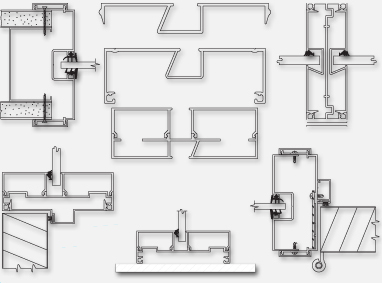
Samples of Versatrac connective components and miscellaneous items
|
|
|
AVAproject, the system automatically selects and draws not only the required frame details, but also the connective components and other miscellaneous items required by the application.
|
Unlike a standard image library, AVAproject automatically selects only the components that are required based on the details in the openings schedule. Although no decisions are necessary on the part of the user, additional items can
|
easily be manually selected if desired
The following is only a small sampling of the numerous CAD-quality frame details included with the Versatrac catalog.
|
|
Once again, this article only contains a small glimpse into the robust libraries contained within the AVAware catalogs. Our teams work tirelessly to produce presentation-quality graphics and catalogs whose feature are unmatched by any other software available anywhere. In the same way that the catalogs’ “intelligent” pricing capabilities enable people with little or no experience to estimate projects, the graphics components of those same catalogs allow anyone to produce professional-quality submissions.
Remember, a submittal package is quite often the first impression an architect or potential customer get of your company. AVAproject helps to make sure that first impression is a great one.
|
|
Most everyone who has had a hand in preparing a division 8 architectural submittal document is keenly aware of how laborious a process it can be. Beyond all the product information and complex pricing that accompanies it, are the variety of graphic-intensive tasks that are key to preparing a professional document. One of the most prominent features of AVAproject, and perhaps the aspect that truly sets it apart from all the others is the elegant way in which it addresses these complex tasks. AVAproject doesn’t merely assist in the process of drawing elevations and profiles, it draws elevations and profiles!
Based upon the information entered in the openings schedules, the system can automatically create frame elevations and cross-sections (“profiles”) automatically. On large projects, the task of organizing all these drawings can be as daunting as the drawing process itself. As such, AVAproject was created with a number of features that help create an efficient and easily-navigated submittal package.
On an opening-by-opening basis, coordinating profiles to their corresponding frame components is a relatively simple matter. The examples below depict two variations of the AVAproject ‘Shop Drawings’. The first shows only the elevation and its cross-sections, while the second also includes a material list. In the first example, each frame “stick” is tagged with a number that corresponds to the appropriate cross-section detail. Sticks with identical profiles are tagged with the same section number. In the second example however, there is more detail. Each frame component is given a unique ‘letter’ tag which corresponds to it in the material list. Each of those lines is then matched up to its corresponding section number. This allows an easy “reading flow”, whether the reader begins with the elevation or the material list.
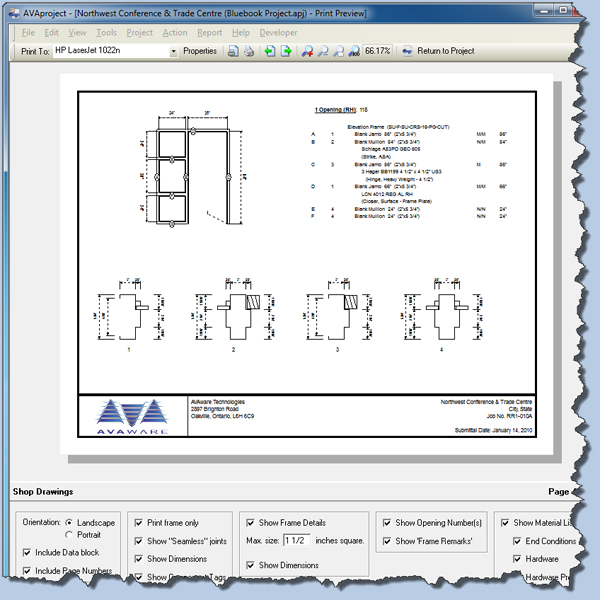
AVAproject Manufacturer Shop Drawings
When dealing with the multitude of elevations that can accompany an entire project, the task of organizing the detail drawings becomes even more important. Inevitably, there are many commonalties between components of various frames. To avoid a bloated submittal documents, AVAproject performs a sorting and bulking operation on all the automatically generated frame profiles. Each unique profile is shown only once regardless of how many frames it relates to throughout the project. At the user’s option, sections numbers (similar to those used in the shop drawings) are shown on each component of each elevation in the submittal. Every frame component that references the same profile will be tagged with the same section number. Needless to say, this dramatically reduces the number of cross-sections required for larger projects.

AVAproject Elevation Drawings with Section Numbers Shown
A practical difficulty arises when another popular AVAproject feature is used in combination with this one. To further reduce the amount of repetition in a submittal package, AVAproject offers the option of bulking together frames that are identical, but for their jamb depths. Obviously, a jamb depth does not affect the appearance of a two-dimensional elevation. As such, it is often considered wasteful to show multiple openings that appear identical. The problem occurs when that same elevation is used in a given project with several different jamb depths. In that case, that same elevation and its components could be cross-referenced to several different frame profiles. As such, it is impractical to display all those sections numbers over top of each frame component. In theory, there could be so many that it would be nearly impossible.
There are two ways to deal with this situation. Obviously, the user can disable the bulking of the similar elevations. This would result in separate elevations being generated for each different jamb depth and each of those referring to their proper frame profiles.
Alternatively, AVAproject offers a special “Section Numbers” column that can be inserted into the openings schedule. When added, the column is displayed with a grey background indicating that no data is to be entered into it. When the submittal document is generated, this column is filled in with the numbers corresponding to the frame profiles that apply to the given opening. The openings schedule becomes an index that “marries” the opening with its elevation and corresponding section numbers. Each time the project is modified, the section numbers are automatically reassigned and updated.
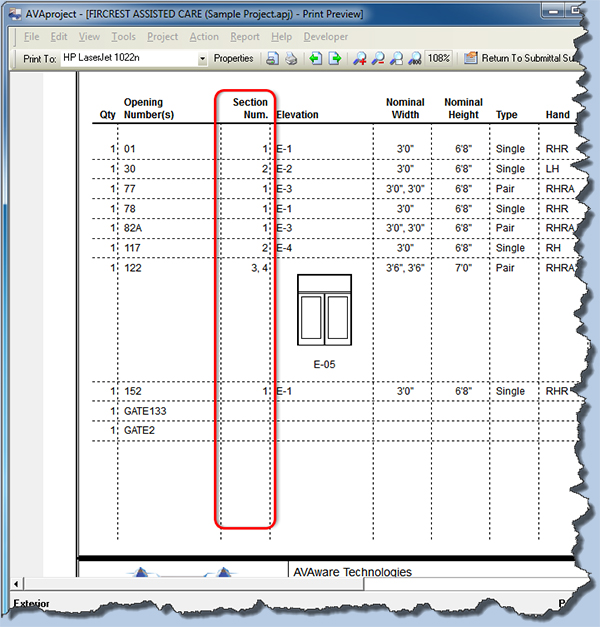
AVAproject Submittal Print Preview - Openings Schedule with Section Number Column Shown
|
|
|
We welcome any questions, comments or suggestions about any topic mentioned in this edition of AVAwire. Please visit our website for more information, or contact us directly at (416) 239-9099.
|
|